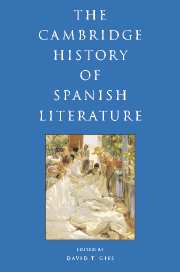Book contents
- Frontmatter
- I INTRODUCTION
- II HISTORY AND CANONICITY
- III THE MEDIEVAL PERIOD
- IV EARLY MODERN SPAIN: RENAISSANCE AND BAROQUE
- V THE ENLIGHTENMENT AND NEOCLASSICISM
- VI THE FORGING OF A NATION: THE NINETEENTH CENTURY
- VII THE MODERN, MODERNISMO, AND THE TURN OF THE CENTURY
- 32 Nineteenth-century women writers
- 33 The Catalan Renaixença
- 34 Great masters of Spanish Modernism
- 35 The poetry of Modernismo in Spain
- 36 Modernism in Catalonia
- 37 Modernist narrative in the 1920s
- 38 Noucentisme
- 39 Ideas, aesthetics, historical studies
- 40 The Catalan Avant-Garde
- VIII TWENTIETH-CENTURY SPAIN AND THE CIVIL WAR
- IX IN AND OUT OF FRANCO SPAIN
- X POST-FRANCO SPANISH LITERATURE AND FILM
- Bibliography
- Index
- References
34 - Great masters of Spanish Modernism
from VII - THE MODERN, MODERNISMO, AND THE TURN OF THE CENTURY
Published online by Cambridge University Press: 28 March 2008
- Frontmatter
- I INTRODUCTION
- II HISTORY AND CANONICITY
- III THE MEDIEVAL PERIOD
- IV EARLY MODERN SPAIN: RENAISSANCE AND BAROQUE
- V THE ENLIGHTENMENT AND NEOCLASSICISM
- VI THE FORGING OF A NATION: THE NINETEENTH CENTURY
- VII THE MODERN, MODERNISMO, AND THE TURN OF THE CENTURY
- 32 Nineteenth-century women writers
- 33 The Catalan Renaixença
- 34 Great masters of Spanish Modernism
- 35 The poetry of Modernismo in Spain
- 36 Modernism in Catalonia
- 37 Modernist narrative in the 1920s
- 38 Noucentisme
- 39 Ideas, aesthetics, historical studies
- 40 The Catalan Avant-Garde
- VIII TWENTIETH-CENTURY SPAIN AND THE CIVIL WAR
- IX IN AND OUT OF FRANCO SPAIN
- X POST-FRANCO SPANISH LITERATURE AND FILM
- Bibliography
- Index
- References
Summary
Durées and family resemblances of Modernism
As literary terms, modernismo and modernista entered into the language of writers, artists, and critics at the turn of the nineteenth century. It is commonly believed that Rubén Darío, in 1888, was the first to speak of modernismo. It was also at the fin de siècle that a significant number of Spanish poets and novelists renewed Spanish letters by producing literary texts deeply influenced by Parnassianism, Symbolism, Pre-Raphaelitism, and decadentism. Some literary critics of that period and many scholars thenceforth have placed this heterogeneous group of innovative writers and their texts under the labels of modernismo and modernista.
Although many contemporary scholars take for granted that modernismo was a syncretic literary movement, at the turn of the century it was still unclear just what modernismo was. In an article published as early as 1901, José María Nogués complained that modernismo had become an omnibus term, likening it to a prism: all optical illusion with no substance. Writers and critics were so baffled that in 1907, the editors of the journal El Nuevo Mercurio (“The New Mercury”) decided to conduct a survey aimed at reining in a term as polysemic as modernismo. Ramón María del Valle-Inclán, Miguel de Unamuno, Eduardo Chávarri, Ramiro de Maeztu, Ernesto Bark, and Manuel Machado, among many others, defined modernismo from very different perspectives and at times in contradictory ways. There has never been complete agreement on the characteristics, origins, or time period of modernismo. In describing modernismo, the aforementioned critics, and others, observed any number of the following: modernismo’s aestheticism and syncretism; its employment of symbolist, decadent, and/or Parnassian techniques and themes; its renewal of and attention to literary form; its search for new modes of expression; modernismo as the culture and literature of the modern age; its subversive and oppositional attitude toward the establishment; modernismo as the essence of literature itself (an idea developed years later by Paul de Man); and modernismo as a synonym of modernity.
- Type
- Chapter
- Information
- The Cambridge History of Spanish Literature , pp. 479 - 499Publisher: Cambridge University PressPrint publication year: 2005



